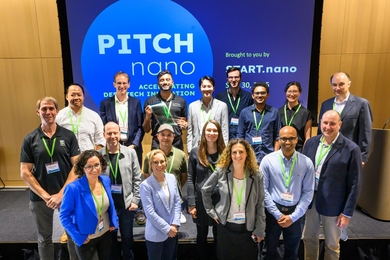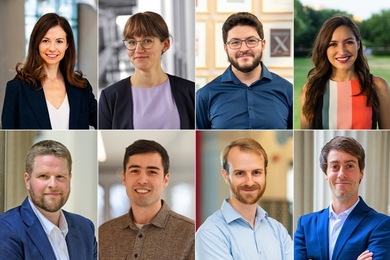Theoretical physicists at MIT recently reported a quantum computer design featuring an array of superconducting islands on the surface of a topological insulator. They propose basing both quantum computation and error correction on the peculiar behavior of electrons at neighboring corners of these islands and their ability to interact across islands at a distance. “The lowest energy state of this system is a very highly entangled quantum state, and it is this state that can be used to encode and manipulate qubits,” says graduate student Sagar Vijay, lead co-author of the paper on the proposed system, with senior author Liang Fu, associate professor of physics at MIT, and Timothy H. Hsieh PhD '15. As Vijay explains it, the proposed system can encode logical qubits that can be read by shining light on them. At the simplest level of explanation, the system can characterize the state of a quantum bit as a zero or a one based on whether there is an odd or even number of electrons associated with a superconducting quantum bit, but the underlying physical interactions that allow this are highly complex.
Earlier work by Fu, performed when he was a graduate student under topological insulator pioneer Charles Kane at the University of Pennsylvania, showed that placing a material known as an s-wave superconductor on the surface of another material that is a strong topological insulator produces special electronic states called Majorana fermions at a triple junctions, where three of these superconductors meet. This is called the “proximity effect.” Thus, the system combines two of the most unusual materials discovered by modern science: superconductors, which allow electricity to flow without resistance, and topological insulators, which allow electricity to flow only on their surface but not through their interior.
The latest work by Fu, Vijay, and Hsieh explains how clusters of these superconducting islands, for example, a set of six islands encircling a single central island, produce these Majorana fermions at each triple junction. The clusters are called plaquettes. It is helpful to think of each Majorana fermion as half of an electron, so they always come in pairs, Vijay suggests. “There is a mathematical trick, which is that you can always write an electron as two Majorana fermions, but there are many physical systems where this actually is the most natural way of representing the system.”
It is these Majorana fermions with their interactions amongst closest neighbors that lead to quantum entanglement. “Each superconducting island has a phase,” Vijay explains. These phases can wind like the hands on a clock and a full rotation of the phase is called a vortex. “Each superconducting vortex on the topological insulator’s surface binds a Majorana fermion. The neat thing is if I have a pair of Majorana fermions, and they are well-separated, it’s as if the electron has become delocalized throughout the system, which is kind of a funny thing to think about,” Vijay says. Engineering the ground state so that each of these superconducting islands winds a full rotation produces an interaction with electrons from each of the six surrounding islands, making this a six-body interaction. “By controlling the strength of the phase fluctuations, you can engineer many-body interactions between Majorana fermions,” Vijay says. These many-body interactions lead to quantum entanglement and are a critical component for both the quantum computing and error correction that the researchers propose.
Another important component of the system is the concept of fermion number parity. “If I have collection of electrons, I would say that the fermion number parity is odd if there an odd number of electrons and the fermion number parity is even if there is an even number of electrons,” Vijay explains. This fermion number parity, that is, whether there is an even, or odd, number of electrons associated with a particular superconducting island, can serve as the basis for a quantum bit, he says. “I want to think of a logical qubit as just the fermion parity of the Majorana fermions surrounding one of these islands,” he says.
This fermion parity can be easily measured. However, Vijay notes, the moment you measure a quantum bit, it yields a definite quantity, whether 0 or 1, and can no longer sit in a quantum “superposition” of both 0 and 1. The trick to using this system at a quantum level then, perhaps counter intuitively, is to not measure the bits you want to preserve as quantum. "Compare this with the situation that we would have more intuition about, which is a spin system, where I have qubits, which are just the individual spins. If I stop measuring the state of two spins, those two spins are not entangled at all. So if I know the state of one spin, that in no way determines the state of another spin that’s very far away. But that’s not true in this highly entangled quantum system, because the nature of these interactions is such that the fermion parity of two particular islands that I’m not measuring will be entangled. Because of this property, something interesting happens, which is that it’s impossible to flip the fermion parity of just a single island,” he says.
A fundamental property of quantum computing is the ability of a quantum bit to simultaneously hold both a 0 and a 1 until a calculation or other logical operation fixes it as a 0 or a 1, at which point it loses its quantum state. Using the analogy of the famous Schrödinger’s cat dilemma, Fu explains, “The motivation for this Majorana code is any time you want to observe the cat, whether it’s alive or dead — even if you prepare the Schrödinger cat in a superposition between alive and dead — once you measure it, it’s either alive or dead,” Fu says. “The quantum information is already lost. At the moment you observe it, the quantum information is gone.”
The researchers preserve their quantum information by continuously measuring the state of surrounding islands but not measuring the ones they define as logical qubits. Vijay summarizes it this way: “I do a measurement of the fermion parity of all of the islands except two, and I define that to be my logical qubit, because that’s a two-level system. Both of the islands are locked in fermion parity, even or odd, so I have two states. I can do that with, let’s say, four islands. I can stop the fermion parity measurements of four islands, and now I would have two logical qubits, so a pair of them are entangled, and then the other pair are entangled.”
Vijay and Hsieh developed a mathematical solution, which they call the Majorana surface code, for correcting errors in this system. “I have this very special type of system where if an error occurs on the qubit that I’m not measuring, then the measurements of the other qubits will tell me what sort of error has occurred,” Vijay says. “The actual protocols for doing the measurements and doing the quantum computing have been studied before, and that’s known theoretically, but actually how to engineer one of these quantum states is rather difficult.” (Hsieh is now a postdoc at the Kavli Institute for Theoretical Physics in Santa Barbara, California.)
Since errors in such a system are inevitable, the problem to solve is how to decode errors when they do occur, Vijay says. “We’re doing measurements of all of the hexagonal islands except a pair of islands, so we have one logical qubit that’s encoded in the system, and that logical qubit is in some state, which is some superposition of 1 and 0. I want to preserve that state.” Using the method of excluding the quantum bits from measurements, he explains, “At time step 1, I measure fermion parity of all the other islands, at time step 2, I do it again, etc., and at time step 2, when I do the measurement, I notice that fermion parity is now different at a certain set of plaquettes, but this entangled quantum state is such that if I know the pattern, that tells me what has happened to the logical qubit, if anything at all, and what I need to do to the logical qubit in order to recover the original information that was stored in it. ... Then I have a course of action, which is when I read out this qubit, I have to interpret this information appropriately because such an error has occurred.” For example, if the environment flipped a one to a zero, then the signature of that error is encoded in the pattern of excitations created around the logical qubit. The coding system would record that error, so whenever a later measurement of this logical qubit is taken, if it is read as a zero, then it should be interpreted as a one.
Vijay got interested in topological insulators while doing undergraduate research at Princeton University, where he received his bachelor’s degree. He is in his third year as a graduate student at MIT and hopes to finish his doctorate in condensed matter theory in another two years. He grew up in the San Jose, California, area.







